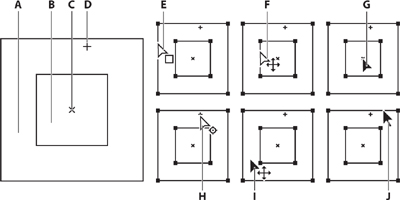Chapter 13. Advanced Editing Techniques
Lesson overview
In this lesson, you’ll learn how to do the following:
• Use motion stabilization to smooth out a shaky camera shot.
• Use single-point motion tracking to track one object in a shot to another object in a shot.
• Perform multipoint tracking using perspective corner-pinning.
• Use Imagineer Systems mocha for After Effects to track motion.
• Create a particle system.
• Use the Timewarp effect to create slow-motion video.
This lesson will take approximately 2 hours to complete. Copy the Lesson13 folder into the Lessons folder that you created on your hard drive for these projects (or create it now), if you haven’t already done so. As you work on this lesson, you’ll preserve the start files. If you need to restore the start files, copy them from the Adobe After Effects CS5 Classroom in a Book DVD.
![]()
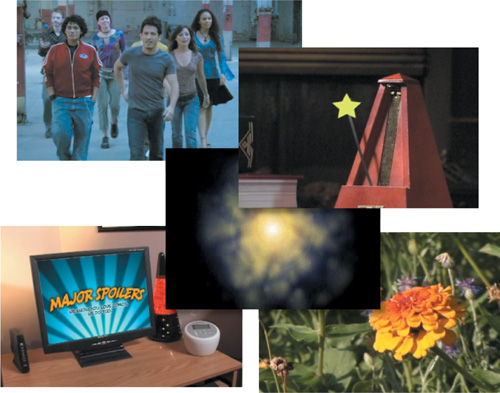
After Effects CS5 provides advanced motion stabilization, motion tracking, high-end effects, and other features for the most demanding production environments.
Getting started
In previous lessons, you’ve used many of the essential 2D and 3D tools you need for motion graphics design. But Adobe After Effects CS5 also offers motion stabilization, motion tracking, advanced keying tools, distortion effects, the capability to retime footage using the Timewarp effect, support for high dynamic range (HDR) color images, network rendering, and much more. In this lesson, you will learn how to use the motion-stabilization and motion-tracking features to stabilize a handheld camera shot and to track one object to another in an image so that their motion is synchronized. Then you will use corner-pinning to track an object with perspective. Finally, you will explore some of the high-end digital effects available in After Effects CS5: a particle system generator and the Timewarp effect.
This lesson includes multiple projects. Take a peek at all of them before beginning.
- Make sure the following files are in the AECS5_CIB/Lessons/Lesson13 folder on your hard disk, or copy them from the Adobe After Effects CS5 Classroom in a Book DVD now:
• In the Assets folder: flowers.mov, Group_Approach[DV].mov, majorspoilers.mov, metronome.mov, mocha_tracking.mov, multipoint_tracking.mov
• In the Sample_Movies folder: Lesson13_Multipoint.mov, Lesson13_Particles.mov, Lesson13_Stabilize.mov, Lesson13_Timewarp.mov, Lesson13_Tracking.mov
- Open and play the sample movies in the Lesson13/Sample_Movies folder to see the projects you will create in this lesson.
- When you’re done, quit QuickTime Player. You may delete these sample movies from your hard disk if you have limited storage space.
Note
You can view these movies all at once or, if you don’t plan to complete these exercises in one session, you can watch each sample movie just before you are ready to complete the associated exercise.
Using motion stabilization
If you shoot footage using a handheld camera, you will probably end up with shaky shots. Unless this look is intentional, you’ll want to stabilize your shots to eliminate unwanted motion.
To stabilize footage, After Effects first tracks the motion in the shot. It then shifts the position and rotation of each frame as necessary to remove the motion. When played back, the motion appears smooth, because the layer itself moves incrementally to offset the unwanted movement.
Setting up the project
As you start After Effects, restore the default application settings for After Effects. See “Restoring default preferences” on page 3.
- Press Ctrl+Alt+Shift (Windows) or Command+Option+Shift (Mac OS) while starting After Effects CS5 to restore default preferences. When asked whether you want to delete your preferences file, click OK.
- Click Close to close the Welcome screen.
After Effects opens to display a new, untitled project.
- Choose File > Save As.
- In the Save As dialog box, navigate to the AECS5_CIB/Lessons/Lesson13/Finished_Projects folder.
- Name the project Lesson13_Stabilize.aep, and then click Save.
Importing the footage
You need to import one footage item to start this project.
- Double-click an empty area of the Project panel to open the Import File dialog box.
- Navigate to the AECS5_CIB/Lessons/Lesson13/Assets folder. Select the flowers.mov file, and then click Open.
Creating the composition
Now, you will create the composition.
- Choose Composition > New Composition.
- In the Composition Settings dialog box, type Stabilize for the name.
- Choose NTSC DV from the Preset pop-up menu. This automatically sets the width, height, pixel aspect ratio, and frame rate for the composition.
- In the Duration field, type 1000 to specify 10 seconds, which matches the length of the flowers.mov file, and then click OK.
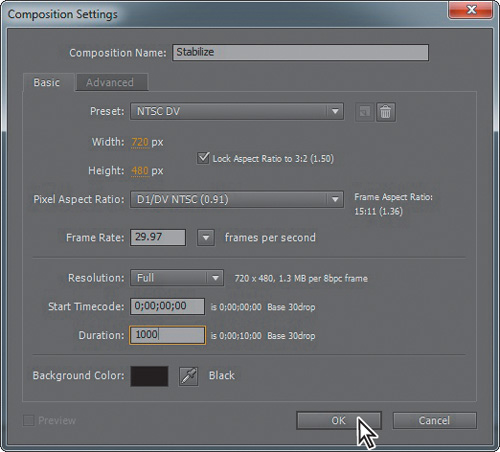
- Drag the flowers.mov item from the Project panel to the Timeline panel. The flowers movie appears in the Composition panel.
- Drag the current-time indicator across the time ruler to manually preview the footage. This clip was shot with a handheld camera in the late afternoon. A slight breeze rustles the vegetation, and the camera moves unsteadily.
Positioning the track points
After Effects tracks motion by matching pixels from a selected area in a frame to pixels in each succeeding frame. You specify the area to track by using track points. A track point contains a feature region, a search region, and an attach point. After Effects displays the track point in the Layer panel as it tracks.
To stabilize this footage, you need to identify areas in the shot that are stationary within the context of the frame. These areas are called the feature regions. This figure shows two feature regions that will work for this project.
It’s important to locate feature regions carefully. For the smoothest tracking, select areas that:
• Are visible for the entire shot.
• Have a contrasting color from the surrounding area.
• Have a distinct shape (at least within the search region).
• Have a consistent shape and color throughout the shot.

You’ll open the Tracking Controls panel and apply track points to the clip.
- Press the Home key, or move the current-time indicator to the beginning of the time ruler.
- Choose Window > Tracker to open the Tracker panel. The Tracker panel is where you specify your motion source and motion target layers, the type of tracking you want to use, and other tracking options.
- Click the Stabilize Motion button in the Tracker panel, and make sure that flowers.mov appears in the Motion Source pop-up menu. This tells After Effects that you want to stabilize the motion in the flowers layer. When you set these options, the Layer panel opens. In the Tracker panel, the Current Track pop-up menu shows Tracker 1, and the Track Type is set to Stabilize.
When you manually previewed the footage, you may have noticed that the camera not only moved left, right, up, and down, but also rotated slightly. So you need to stabilize the shot’s rotation as well as its position.
- Select Position and Rotation in the Tracker panel. You should see two track point indicators in the Layer panel.

Notice that Motion Target is the flowers.mov layer. When you stabilize a shot, the resulting data can be applied to the original layer, as specified here, or you can select another layer by clicking the Edit Target button. Leave it set to flowers.mov.
Now you’re ready to set your track points.
- Using the Selection tool (
 ), drag the Track Point 1 indicator (from the center) in the Layer panel to position it over the first feature region, which is the light green, closed flower bud below and to the left of the orange flower in the foreground.
), drag the Track Point 1 indicator (from the center) in the Layer panel to position it over the first feature region, which is the light green, closed flower bud below and to the left of the orange flower in the foreground. - Drag the Track Point 2 indicator (from the center) to the second feature region, which is the light green leaf to the right of the orange foreground flower.

Analyzing and applying stabilization
Now that the two track points are defined, After Effects can analyze the data and then apply the stabilization tracker.
- Click the Analyze Forward button (
 ) in the Tracker panel. After Effects analyzes the motion stabilization for the duration of the clip.
) in the Tracker panel. After Effects analyzes the motion stabilization for the duration of the clip. - When the analysis is complete, click the Apply button.

- In the Motion Tracker Apply Options dialog box, click OK to apply the stabilization to the x and y dimensions.
The motion-tracking data is added to the flowers layer in the Timeline panel, where you can see the track points, their properties, and their keyframes. If you scroll down in the Timeline panel, you can also see the Anchor Point, Position, and Rotation keyframes that were applied to the layer. Keyframes are created at every frame, so 300 have been created for this 10-second shot. After Effects also opens the flowers movie in the Composition panel again.

- Hide the properties for the flowers layer in the Timeline panel.
- Press the Home key, or move the current-time indicator to the beginning of the timeline, and then watch a RAM preview of the stabilized shot. Press the spacebar to stop playback when you’re ready.
Scaling the layer
You’ve stabilized the footage, but there’s still a problem. The tracking was applied to the Anchor Point and Rotation properties of the layer, but the entire layer is moving and rotating. This means you can see the edge of the shot and the empty space around it in some frames. An easy way to fix this is to scale the layer.
- Go to the beginning of the time ruler.
- With the flowers layer selected in the Timeline panel, press the S key to display its Scale property.
- Drag the current-time indicator across the time ruler until you find the frame where the layer displacement is the greatest (around 7:16).

- Increase the Scale values to 110, 110%. The clip fills the frame completely.

- Go to 2:16, where you can still see some of the empty area outside of the shot.

Because the tracking data is applied to the anchor point of the layer, you can reposition the entire layer without destabilizing it.
- With the flowers layer selected in the Timeline panel, press P to reveal its Position property. The tracker added an initial Position keyframe to the layer. You don’t need it, so click the stopwatch icon (
 ) to delete the keyframe.
) to delete the keyframe. - Change the Position values to 325, 375.

- Manually preview the clip once more to check for additional edge slips. You may need to scale the layer another percentage or two. When you’re done, go to 0:00.
- Watch another RAM preview. The shot should now look rock-steady, with the only movement being caused by the wind rustling the flowers.
- Press the spacebar to stop playback when you’re done.
- Close the properties for the flowers layer in the Timeline panel, and choose File > Save to save your work.
- Choose File > Close Project.
As you have discovered, stabilizing a shot is not without its drawbacks. To compensate for the movement or rotation data applied to the layer, you need to adjust the Scale and Position properties, which could ultimately degrade the footage. If you really need to use the shot in your production, this may be the best compromise.
Using single-point motion tracking
With the increase in the number of productions that incorporate digital elements into final shots, compositors need an easy way to synchronize computer-generated effects with film or video backgrounds. After Effects lets you do this with the capability to follow, or track, a defined area in the shot, and to apply that movement to other layers. These layers can contain text, effects, images, or other footage. The resulting visual effect precisely matches the original moving footage.
When you track motion in an After Effects composition that contains multiple layers, the default tracking type is Transform. This type of motion tracking tracks position and/or rotation to apply to another layer. When tracking position, this option creates one track point, and generates Position keyframes. When tracking rotation, this option creates two track points, and produces Rotation keyframes.
In this exercise, you will track a shape layer to the weighted arm of a metronome. This will be especially challenging because the camera operator chose not to use a tripod.
Setting up the project
If you’ve just completed the first project, and After Effects is open, skip to step 3. Otherwise, restore the default application settings for After Effects. See “Restoring default preferences” on page 3.
- Press Ctrl+Alt+Shift (Windows) or Command+Option+Shift (Mac OS) while starting After Effects CS5 to restore default preferences. When asked whether you want to delete your preferences file, click OK.
- Click Close to close the Welcome screen.
- Choose File > Save As.
- In the Save As dialog box, navigate to the AECS5_CIB/Lessons/Lesson13/Finished_Projects folder.
- Name the project Lesson13_Tracking.aep, and then click Save.
Importing the footage
You need to import one footage item to start this project.
- Double-click an empty area of the Project panel to open the Import File dialog box.
- Navigate to the AECS5_CIB/Lessons/Lesson13/Assets folder. Select the metronome.mov file, and then click Open.
Creating the composition
Now, you will create the composition.
- Choose Composition > New Composition.
- In the Composition Settings dialog box, type Tracking in the Composition Name field.
- Make sure the Preset pop-up menu is set to NTSC DV. This automatically sets the width, height, pixel aspect ratio, and frame rate for the composition.
- In the Duration field, type 800 to specify 8 seconds, which matches the length of the metronome.mov file, and then click OK.
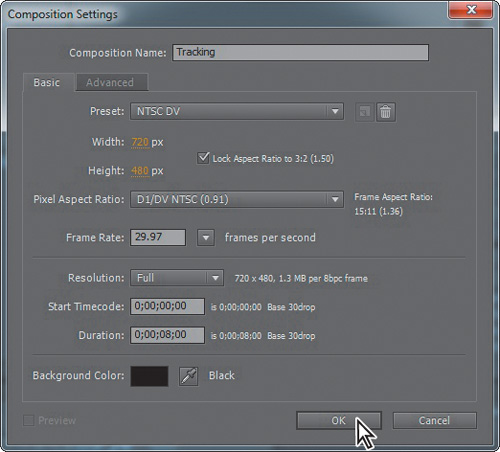
- Drag the metronome.mov item from the Project panel to the Timeline panel. The metronome image appears in the Composition panel.
- Drag the current-time indicator across the time ruler to manually preview the footage.
Creating a shape layer
You’re going to attach a star to the end of the metronome. First, you need to create the star. You’ll use a shape layer.
- Press the Home key, or move the current-time indicator to the beginning of the time ruler, and then click an empty area of the Timeline panel to deselect the layer.
- Select the Star tool (
 ), hidden behind the Rectangle tool in the Tools panel.
), hidden behind the Rectangle tool in the Tools panel. - Click the Fill Color swatch, and select a light yellow such as R=220, G=250, B=90. Click the word Stroke, select None in the Stroke Options dialog box, and click OK.

- In the Composition panel, draw a small star.
- Use the Selection tool to position the star over the weighted end of the pendulum arm.
- Select Shape Layer 1 to see the layer’s anchor point. Use the Pan Behind tool to move the anchor point in the center of the star shape, if it isn’t already there.

Positioning the track point
You will track the metronome weight (the rhombus at the end of its arm) using the same tracking controls you used with the flowers. However, unlike motion stabilization, you need to place tracking regions around the area that you’ll track another layer to. With the star shape added to the Tracking composition, you are ready to position the track point.
- Select the metronome.mov layer in the Timeline panel.
- Choose Window > Tracker to open the Tracker panel, if it’s not already open.
- Click the Track Motion button in the Tracker panel. The Layer panel opens, with a Track Point 1 indicator in the center of the image.
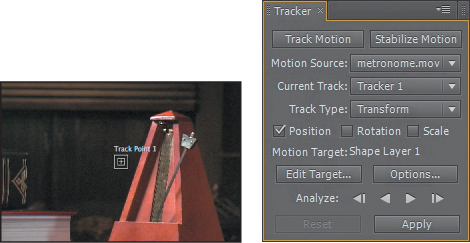
Notice the settings in the Tracker panel: The Motion Source is set to metronome.mov. The Current Track is Tracker 1, and the Motion Target is Shape Layer 1, because After Effects automatically sets the Motion Target to the layer immediately above the source layer.
Now, you’ll position your track point.
- Using the Selection tool (
 ), move the Track Point 1 indicator (from the center) in the Layer panel over the metronome weight.
), move the Track Point 1 indicator (from the center) in the Layer panel over the metronome weight. - Enlarge the search region (the outer box) to encompass the area around the pendulum. Then adjust the feature region (the inner box) within the weight.
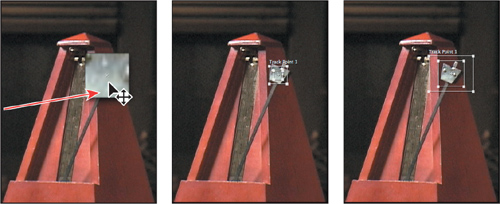
Note
In this exercise, you want the star to move atop the metronome weight. However, if you wanted an object to move in relationship to the tracked area but not on top of it, you could reposition the attach point accordingly.
Analyzing and applying tracking
Now that the search and feature regions are defined, you can apply the tracker.
- Click the Analyze Forward button (
 ) in the Tracker panel. Watch the analysis to ensure the track point stays with the metronome weight. If it doesn’t, stop the analysis and reposition the feature region. (See the sidebar, “Checking for drift.”)
) in the Tracker panel. Watch the analysis to ensure the track point stays with the metronome weight. If it doesn’t, stop the analysis and reposition the feature region. (See the sidebar, “Checking for drift.”) - When the analysis is complete, click the Apply button.
- In the Motion Tracker Apply Options dialog box, click OK to apply the tracking to the x and y dimensions.
Note
The tracking analysis may take quite a while. The larger the search and feature regions, the longer After Effects takes to analyze tracking.
The motion-tracking data is added to the Timeline panel, where you can see that the track data is in the metronome layer, but the results are applied to the Position property of the Shape Layer 1 layer. This is another difference between tracking and stabilization: The resulting data is applied to a layer’s position, rather than to its anchor point.
- Watch a RAM preview. The star not only follows the pendulum; it moves with the camera’s movement.
- When you’re ready, press the spacebar to stop playback.
- Hide the properties for both layers in the Timeline panel, choose File > Save, and then choose File > Close Project.
Motion tracking an element onto background footage can be fun. As long as you have a stable feature to track, single-point motion tracking can be quite easy.
Using multipoint tracking
After Effects also offers two more advanced types of tracking that use multiple tracking points: parallel corner-pinning and perspective corner-pinning.
When you track using parallel corner-pinning, you simultaneously track three points in the source footage. After Effects calculates the position of a fourth point to keep the lines between the points parallel. When the movement of the points is applied to the target layer, the Corner Pin effect distorts the layer to simulate skew, scale, and rotation, but not perspective. Parallel lines remain parallel, and relative distances are preserved.
When you track using perspective corner-pinning, you simultaneously track four points in the source footage. When applied to the target footage, the Corner Pin effect uses the movement of the four points to distort the layer, simulating changes in perspective.
You’ll attach an animation to a computer monitor using perspective corner-pinning. If you haven’t already watched the sample movie for this exercise, do so now.
Setting up the project
Start by launching After Effects and creating a new project.
- If it’s not already open, start After Effects. Press Ctrl+Alt+Shift (Windows) or Command+Option+Shift (Mac OS) as you start it to restore default preferences. Click OK when asked whether you want to delete your preferences file, and click Close to close the Welcome screen.
After Effects opens to display an empty, untitled project.
- Choose File > Save As.
- In the Save As dialog box, navigate to the AECS5_CIB/Lessons/Lesson13/Finished_Projects folder.
- Name the project Lesson13_Multipoint.aep, and then click Save.
Importing the footage
You need to import two footage items for this exercise.
- Double-click an empty area of the Project panel to open the Import File dialog box.
- Navigate to the AECS5_CIB/Lessons/Lesson13/Assets folder.
- Ctrl-click (Windows) or Command-click (Mac OS) to select the majorspoilers.mov and multipoint_tracking.mov files, and then click Open.
Creating the composition
Now, you’ll create a new composition.
- Press Ctrl+N (Windows) or Command+N (Mac OS).
- In the Composition Settings dialog box, type Multipoint_Tracking in the Composition Name field.
- Make sure the Preset pop-up menu is set to NTSC DV. This automatically sets the width, height, pixel aspect ratio, and frame rate for the composition.
- Set the Duration to 7:05, which matches the length of the majorspoilers.mov file, and then click OK.

You will now add the footage items to the Timeline panel, one at a time.
- Drag the multipoint_tracking.mov item from the Project panel to the Timeline panel. It automatically appears in the Composition panel.
- Manually preview the footage, which is shaky because it was shot with a handheld camera.
Because you’re positioning the majorspoilers.mov layer on the computer monitor, it will be fairly easy to place tracking markers on the flat plane. By default, the tracker tracks by luminance, so you will use the areas around the screen that have high contrast differences for tracking.
- Press the Home key, or move the current-time indicator to the beginning of the time ruler.
- Drag the majorspoilers.mov footage item from the Project panel to the Timeline panel, placing it at the top of the layer stack.
- To make it easier to see the underlying movie as you place the tracking points, turn off the Video switch for the majorspoilers.mov layer in the Timeline panel.

Positioning the track points
You’re ready to add the track points to the multipoint_tracking.mov layer.
- Select the multipoint_tracking.mov layer in the Timeline panel.
- Choose Window > Tracker to open the Tracker panel if it isn’t open.
- In the Tracker panel, choose multipoint_tracking.mov from the Motion Source menu.
- Select the multipoint_tracking.mov layer again, and then click Track Motion. The desk scene opens in the Layer panel, with a track point indicator in the center of the image. However, you will be tracking four points in order to attach the animated movie to the computer screen.
- Choose Perspective Corner Pin from the Track Type menu. Three more track point indicators appear in the Layer panel.

- Drag the track points to four different high-contrast areas of the image. The four corners of the computer screen provide excellent contrast. Use the following image as a guide. (Because the areas of high contrast are also where you want to attach the majorspoilers layer, you don’t need to move the attach points.)
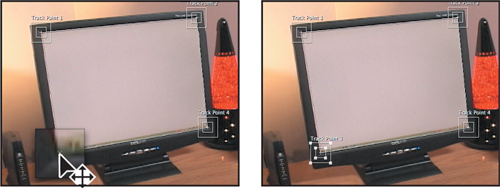
Tip
Refer to the sidebar, “Moving and resizing the track points,” for help moving the track point regions.
Tip
It may be helpful to zoom in when placing and adjusting the track points. Zoom out again when you have finished.
Applying the multipoint tracker
You’re ready to analyze the data and apply the tracker.
- Click the Analyze Forward button (
 ) in the Tracker panel. Then, when the analysis is complete, click the Apply button to calculate the tracking.
) in the Tracker panel. Then, when the analysis is complete, click the Apply button to calculate the tracking. - Notice the results in the Timeline panel: You can see the Corner Pin and Position property keyframes for the majorspoilers layer and the track point data for the motion_tracking layer.
- Make the majorspoilers layer visible again, move the current-time indicator to the beginning of the timeline, and watch a RAM preview to see the results of the tracker.
- When you’re done watching the preview, press the spacebar to stop playback.
Note
If the composition doesn’t appear in the Composition panel, click in the Timeline window to move the current-time indicator and refresh the display.
If you don’t like the results, return to the Tracker panel, click the Reset button, and try again. With practice, you will become adept at identifying good feature regions.
- Hide the layer properties to keep the Timeline panel neat, and choose File > Save to save your work.
- Choose File > Close Project.
Creating a particle simulation
After Effects includes several effects that do an excellent job of creating particle simulations. Two of them—CC Particle Systems II and CC Particle World—are based on the same engine. The major difference between the two is that Particle World enables you to move the particles in 3D space, rather than a 2D layer.
In this exercise, you’ll learn how to use the CC Particle Systems II effect to create a supernova that could be used as the opening of a science program or as a motion background. If you haven’t already watched the sample movie for this exercise, do so now before continuing.
Setting up the project
Start by launching After Effects and creating a new project.
- If it’s not already open, start After Effects: Press Ctrl+Alt+Shift (Windows) or Command+Option+Shift (Mac OS) as you start it to restore default preferences. Click OK when asked whether you want to delete your preferences file, and click Close to close the Welcome screen.
After Effects opens to display an empty, untitled project.
- Choose File > Save As.
- In the Save As dialog box, navigate to the AECS5_CIB/Lessons/Lesson13/Finished_Projects folder.
- Name the project Lesson13_Particles.aep, and then click Save.
Creating the composition
You don’t need to import any footage items for this exercise. However, you do need to create the composition.
- In After Effects, press Ctrl+N (Windows) or Command+N (Mac OS).
- In the Composition Settings dialog box, type Supernova in the Composition Name field.
- Choose NTSC D1 from the Preset pop-up menu. This automatically sets the width, height, pixel aspect ratio, and frame rate for the composition.
- Set the Duration to 10:00, and then click OK.

Creating a particle system
You will build the particle system from a solid layer, so you’ll create that next.
- Choose Layer > New > Solid to create a new solid layer.
- In the Solid Settings dialog box, type Particles in the Name box.
- Click Make Comp Size to make the layer the same size as the composition. Then click OK.
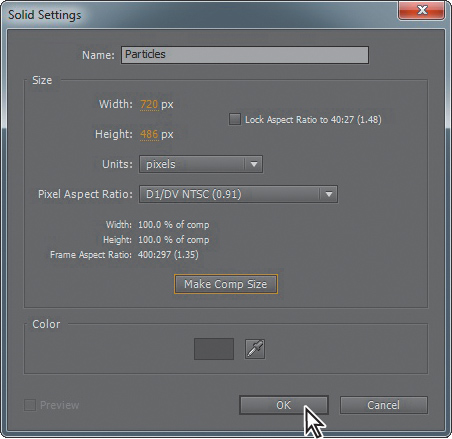
- With the Particles layer selected in the Timeline panel, choose Effect > Simulation > CC Particle Systems II.
- Go to 4:00 to see the particle system.

A large stream of yellow particles appears in the Composition panel.
Customizing the particle effect
You will turn this stream of particles into a supernova by customizing the settings in the Effect Controls panel.
- Expand the Physics property group in the Effect Controls panel. The Explosive Animation setting works fine for this project, but instead of the particles falling down, you want them to flow out in all directions, so change the Gravity value to 0.0.

- Hide the Physics property group, and expand the Particle property group. Then choose Faded Sphere from the Particle Type menu.
Now the particles look intergalactic. Don’t stop there, though.
- Change the Death Size to 1.50, and increase the Size Variation to 100%. This allows the particles to change birth size randomly.
- Reduce the Max Opacity to 55%. This make the particles semi-transparent.

- Click the Birth Color swatch, and change the color to R=255, G=200, B=50 to give the particles a yellow hue on birth. Then click OK.
- Click the Death Color swatch, and change the color to R=180, G=180, B=180 to give the particles a light gray hue as they fade out. Then click OK.

- To keep the particles from staying onscreen too long, decrease the Longevity value to 0.8 seconds.
Note
Even though they’re at the top of the Effect Controls panel, it is often easier to adjust the Longevity and Birth Rate settings after you have set the other particle properties.

The Faded Sphere particle type softens the look, but the particle shapes are still too sharply defined. You will fix that by blurring the layer to blend the particles with one another.
- Hide the CC Particle Systems II effect properties.
- Choose Effect > Blur & Sharpen > Fast Blur.
- In the Fast Blur area of the Effect Controls panel, increase the Blurriness value to 10. Then select Repeat Edge Pixels to keep the particles from being cropped at the edge of the frame.

Creating the sun
You will now create a bright halo of light that will go behind the particles.
- Go to 0:07.
- Press Ctrl+Y (Windows) or Command+Y (Mac OS) to create a new solid layer.
- In the Solid Settings dialog box, do the following:
• Type Sun in the Name box.
• Click Make Comp Size to make the layer the same size as the composition.
• Click the color swatch to make the layer the same yellow as the Birth Color of the particles (255, 200, 50).
• Click OK to close the Solid Settings dialog box.
- Drag the Sun layer below the Particles layer in the Timeline panel.
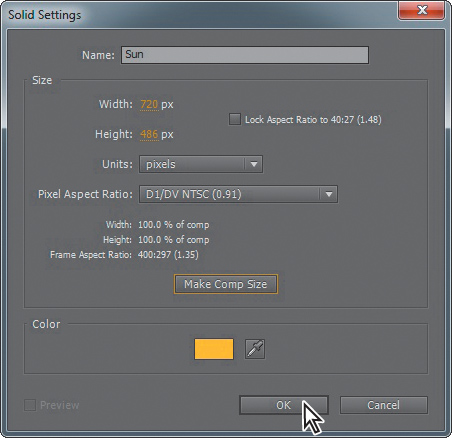
- Select the Ellipse tool (
 ), which is hidden behind the Rectangle tool (
), which is hidden behind the Rectangle tool ( ) or the Star tool (
) or the Star tool ( ) in the Tools panel, and Shift-drag in the Composition panel to draw a circle with a radius of roughly 100 pixels, or one-fourth the width of the composition.
) in the Tools panel, and Shift-drag in the Composition panel to draw a circle with a radius of roughly 100 pixels, or one-fourth the width of the composition. - Using the Selection tool (
 ), drag the mask shape to the center of the Composition panel.
), drag the mask shape to the center of the Composition panel.

- With the Sun layer selected in the Timeline panel, press the F key to reveal its Mask Feather property. Increase the Mask Feather amount to 100, 100 pixels.

- Press Alt+[ (Window) or Option+[ (Mac OS) to set the In point of the layer to the current time.

- Hide the properties for the Sun layer.
Lighting the darkness
Since the sun is bright, it should illuminate the surrounding darkness.
- Make sure the current-time indicator is still at 0:07.
- Press Ctrl+Y (Windows) or Command+Y (Mac OS) to create a new solid layer.
- In the Solid Settings dialog box, name the layer Background, click the Make Comp Size button to make the layer the same size as the composition, and then click OK to create the layer.
- In the Timeline panel, drag the Background layer to the bottom of the layer stack.
- With the Background layer selected in the Timeline panel, choose Effect > Generate > Ramp.
The Ramp effect creates a color gradient, blending it with the original image. You can create linear or radial ramps, and vary the position and colors of the ramp over time. Use the Start Of Ramp and End Of Ramp settings to specify the start and end positions. Use the Ramp Scatter setting to disperse the ramp colors and eliminate banding.
- In the Ramp area of the Effect Controls panel, do the following:
• Change Start Of Ramp to 360, 240 and End Of Ramp to 360, 525.
• Choose Radial Ramp from the Ramp Shape menu.
• Click the Start Color swatch, and set the start color to dark blue (R=0, G=25, B=135).
• Set the End Color to black (R=0, G=0, B=0).

- Press Alt+[ (Windows) or Option+[ (Mac OS) to set the In point of the layer to the current time.
Adding a lens flare
To tie all the elements together, add a lens flare to simulate an explosion.
- Press the Home key, or move the current-time indicator to the beginning of the time ruler.
- Press Ctrl+Y (Windows) or Command+Y (Mac OS) to create a new solid layer.
- In the Solid Settings dialog box, name the layer Nova, click the Make Comp Size button to make the layer the same size as the composition, set the Color to black (R=0, G=0, B=0), and then click OK. The Nova layer should be at the top of the layer stack in the Timeline panel.
- With the Nova layer selected in the Timeline panel, choose Effect > Generate > Lens Flare.
- In the Lens Flare area of the Effect Controls panel, do the following:
• Change Flare Center to 360, 240.
• Choose 50–300mm Zoom from the Lens Type menu.
• Decrease Flare Brightness to 0%, and then click the Flare Brightness stopwatch icon (
 ) to create an initial keyframe.
) to create an initial keyframe. - Go to 0:10.
- Increase the Flare Brightness to 240%.
- Go to 1:04, and decrease the Flare Brightness to 100%.

- With the Nova layer selected in the Timeline panel, press the U key to see the animated Lens Flare property.
- Right-click (Windows) or Control-click (Mac OS) the ending Flare Brightness keyframe, and choose Keyframe Assistant > Easy Ease In.
- Right-click (Windows) or Control-click (Mac OS) the beginning Flare Brightness keyframe, and choose Keyframe Assistant > Easy Ease Out.

Finally, you need to make the layers under the Nova layer visible in the composition.
- Press F2 to deselect all layers, and choose Columns > Modes from the Timeline panel menu. Then choose Screen from the Mode menu for the Nova layer.

- Watch a RAM preview. When you’re done, press the spacebar to stop the preview.
- Choose File > Save, and then choose File > Close Project.
Retiming playback using the Timewarp effect
The Timewarp effect in After Effects CS5 gives you precise control over a wide range of parameters when changing the playback speed of a layer, including interpolation methods, motion blur, and source cropping to eliminate unwanted artifacts.
In this exercise, you will use the Timewarp effect to change the speed of a clip for a dramatic slow-motion playback. If you haven’t already watched the sample movie for this exercise, do so now.
Setting up the project
Start by launching After Effects and creating a new project.
- If After Effects isn’t open, start it. Press Ctrl+Alt+Shift (Windows) or Command+Option+Shift (Mac OS) as you start it to restore default preferences. Click OK when asked whether you want to delete your preferences file, and click Close to close the Welcome screen.
After Effects opens to display an empty, untitled project.
- Choose File > Save As.
- In the Save As dialog box, navigate to the AECS5_CIB/Lessons/Lesson13/Finished_Projects folder.
- Name the project Lesson13_Timewarp.aep, and then click Save.
Importing the footage and creating the composition
You need to import one footage item for this exercise.
- Double-click an empty area of the Project panel to open the Import File dialog box.
- Navigate to the AECS5_CIB/Lessons/Lesson13/Assets folder on your hard disk, select the Group_Approach[DV].mov, and click Open.
- Click OK in the Interpret Footage dialog box.
Now, you’ll create a new composition based on the footage item’s aspect ratio and duration.
- Drag the Group_Approach[DV].mov file onto the Create A New Composition button (
 ) at the bottom of the Project panel. After Effects creates a new composition named for the source file and displays it in the Composition and Timeline panels.
) at the bottom of the Project panel. After Effects creates a new composition named for the source file and displays it in the Composition and Timeline panels.

- Choose File > Save to save your work.
Using Timewarp
In the source footage, a group of young people approaches the camera at a steady pace. At around 2 seconds, the director would like the motion to begin to slow down to 10%, and then ramp back up to full speed at 7:00.
- With the Group_Approach [DV] layer selected in the Timeline panel, choose Effect > Time > Timewarp.
- In the Timewarp area of the Effect Controls panel, choose Pixel Motion from the Method menu. This instructs Timewarp to create new frames by analyzing the pixel movement in nearby frames and creating motion vectors. Also, choose Speed from the Adjust Time By menu, to control the time adjustment by percentage rather than by a specific frame.
- Go to 2:00.
- In the Effect Controls panel, set the Speed to 100, and click the stopwatch (
 ) to set a keyframe. This tells Timewarp to keep the speed of the clip at 100% until the 2-second mark.
) to set a keyframe. This tells Timewarp to keep the speed of the clip at 100% until the 2-second mark.

- Go to 5:00, and change the Speed to 10. After Effects adds a keyframe.
- Go to 7:00, and set the Speed to 100. After Effects adds a keyframe.
- Press the Home key, or move the current-time indicator to the beginning of the time ruler, and then watch a RAM preview of the effect.
Note
Be patient. The RAM preview might take some time to calculate, but it will provide a more accurate playback than a spacebar preview.
You will see that the speed adjustments are rather abrupt—not the smooth, slow-motion curve you would expect to see in a professional effect. This is because the keyframes are linear instead of curved. You’ll fix that next.
- Press the spacebar to stop playback when you’re ready.
- With the Group_Approach[DV] layer selected in the Timeline panel, press the U key to see the animated Timewarp Speed property.
- Click the Graph Editor button (
 ) in the Timeline panel so you can see the Graph Editor instead of the layer bars. The Graph Editor displays the graph for the Speed property name for the Group_Approach[DV] layer.
) in the Timeline panel so you can see the Graph Editor instead of the layer bars. The Graph Editor displays the graph for the Speed property name for the Group_Approach[DV] layer.

- Click to select the first Speed keyframe (at 2:00), and then click the Easy Ease icon (
 ) at the bottom of the Graph Editor. This adjusts the influence into and out of the keyframe to smooth out sudden changes.
) at the bottom of the Graph Editor. This adjusts the influence into and out of the keyframe to smooth out sudden changes. - Repeat step 11 for the other two Speed keyframes in the motion graph, at 5:00 and 7:00.
Tip
Close columns in the Timeline panel to see more icons in the Graph Editor. You can also apply an Easy Ease adjustment by pressing the F9 key.
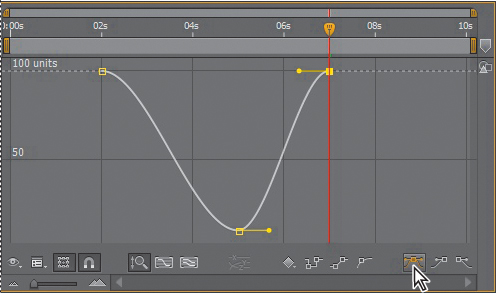
The motion graph is now smoother, but you can tweak it even more by dragging the Bezier handles.
- Using the Bezier handles for the keyframes at 2:00 and 5:00, adjust the curve so that it resembles the following image.

- Watch another RAM preview. Now, the slow-motion Timewarp effect looks professional.
- Choose File > Save to save the project, and then choose File > Close Project.
You’ve now experimented with some of the advanced features in After Effects, including motion stabilization, motion tracking, particle systems, and the Timewarp effect. To render and export any or all of the projects you completed in this lesson, see Lesson 14, “Rendering and Outputting,” for instructions.
Review questions
1 What is motion stabilization, and when do you need to use it?
2 Why might drifting occur when you’re tracking an image?
3 What is the birth rate in a particle effect?
4 What does the Timewarp effect do?
Review answers
1 Shooting footage using a handheld camera typically results in shaky shots. Unless this look is intentional, you will want to stabilize the shots to eliminate unwanted motion. Motion stabilization in After Effects works by analyzing the movement and rotation of the target layer, and then applying the opposite values to the anchor point and rotation of that layer. When played back, the motion appears smooth because the layer itself moves incrementally to offset the unwanted motion.
2 Drifting occurs when the feature region loses the feature that’s being tracked. As an image moves in a shot, the lighting, surrounding objects, and angle of the object can change, making a once-distinct feature unidentifiable at the subpixel level. Even with careful planning and practice, the feature region often drifts away from the desired feature. Readjusting the feature and search regions, changing the tracking options, and trying again are a standard part of digital tracking.
3 The birth rate in a particle effect determines how often new particles are created.
4 The Timewarp effect gives you precise control over a wide range of parameters to change the playback speed of a layer, including interpolation methods, motion blur, and source cropping to eliminate unwanted artifacts.

